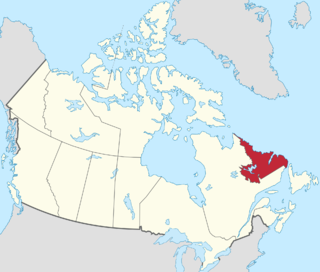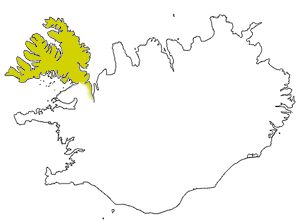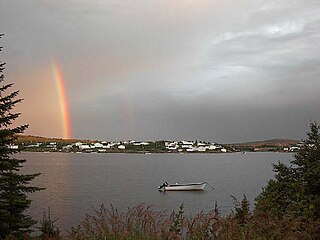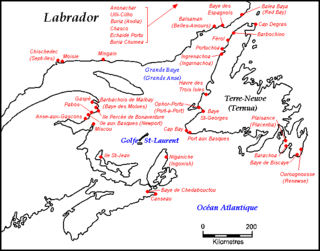Related Research Articles
A pidgin, or pidgin language, is a grammatically simplified means of communication that develops between two or more groups of people that do not have a language in common: typically, its vocabulary and grammar are limited and often drawn from several languages. It is most commonly employed in situations such as trade, or where both groups speak languages different from the language of the country in which they reside. Linguists do not typically consider pidgins as full or complete languages.

Labrador is a geographic and cultural region within the Canadian province of Newfoundland and Labrador. It is the primarily continental portion of the province and constitutes 71% of the province's area but is home to only 6% of its population. It is separated from the island of Newfoundland by the Strait of Belle Isle. It is the largest and northernmost geographical region in the four Atlantic provinces.
The Strait of Belle Isle is a waterway in eastern Canada that separates the Labrador Peninsula from the island of Newfoundland, in the province of Newfoundland and Labrador.

The 16th century in Canada saw the first contacts, since the Norsemen 500 years earlier, between the indigenous peoples in Canada living near the Atlantic coast and European fishermen, whalers, traders, and explorers.

Nunatsiavut is an autonomous area claimed by the Inuit in Newfoundland and Labrador, Canada. The settlement area includes territory in Labrador extending to the Quebec border. In 2002, the Labrador Inuit Association submitted a proposal for limited autonomy to the government of Newfoundland and Labrador. The constitution was ratified on December 1, 2005, at which time the Labrador Inuit Association ceased to exist, and the new Government of Nunatsiavut was established, initially being responsible for health, education and cultural affairs. It is also responsible for setting and conducting elections, the first of which was executed in October 2006. An election for the ordinary members of the Nunatsiavut Assembly was held on May 4, 2010. The Nunatsiavut Assembly was dissolved on April 6 in preparation for the election. Its incumbent president is Johannes Lampe who assumed office in 2016.

Inuktitut, also known as Eastern Canadian Inuktitut, is one of the principal Inuit languages of Canada. It is spoken in all areas north of the tree line, including parts of the provinces of Newfoundland and Labrador, Quebec, to some extent in northeastern Manitoba as well as the Northwest Territories and Nunavut. It is one of the aboriginal languages written with Canadian Aboriginal syllabics.

A multitude of languages have always been spoken in Canada. Prior to Confederation, the territories that would become Canada were home to over 70 distinct languages across 12 or so language families. Today, a majority of those indigenous languages are still spoken; however, most are endangered and only about 0.6% of the Canadian population report an Indigenous language as their mother tongue. Since the establishment of the Canadian state, English and French have been the co-official languages and are, by far, the most spoken languages in the country today.

Channel-Port aux Basques is a town at the extreme southwestern tip of Newfoundland fronting on the western end of the Cabot Strait. A Marine Atlantic ferry terminal is located in the town which is the primary entry point onto the island of Newfoundland and the western terminus of the Newfoundland and Labrador Route 1 in the province. The town was incorporated in 1945 and its population in the 2021 census was 3,547.

Postville is an Inuit town in the north of Labrador, Canada. It had a population of 188 as of 2021. It is located about 40 km (25 mi) into the interior of Kaipokok Bay, 180 km (110 mi) NNE of Happy Valley-Goose Bay. Postville Airport is nearby.
Acoutsina, was an Inuit from Labrador who was enslaved by Augustin le Gardeur de Courtemanche. During her captivity she taught François Martel de Brouague, his stepson and a French colonist and commandant of the coast of Labrador, the language of her people, while she learned French. After a few years in captivity, her father came to the fort and secured her release. Historians analyse records of her captivity for information on French-Indigenous relationships.

The Basque–Icelandic pidgin was a Basque-based pidgin spoken in Iceland in the 17th century. It consisted of Basque, Germanic and Romance words.

Inuit are a group of culturally similar indigenous peoples inhabiting the Arctic and subarctic regions of Greenland, Labrador, Quebec, Nunavut, the Northwest Territories, and Alaska. Inuit languages are part of the Eskimo–Aleut languages, also known as Inuit-Yupik-Unangan, and also as Eskaleut. Inuit Sign Language is a critically endangered language isolate used in Nunavut.
The NunatuKavummiut are a people formally recognized by the federal government as among the Indigenous peoples in Canada. They live in central to southern Labrador, and are of mixed Inuit and European heritage. According to recent censuses completed by Statistics Canada, the vast majority of individuals living in NunatuKavut communities identify as Inuit'Métis' as opposed to 'Inuit'. However, they are unrelated to the Metis people of the Red River Colony of Western Canada.

Inuit Nunangat is the homeland of the Inuit in Canada. This Arctic homeland consists of four northern Canadian regions called the Inuvialuit Settlement Region, the territory Nunavut (ᓄᓇᕗᑦ), Nunavik (ᓄᓇᕕᒃ) in northern Québec, and Nunatsiavut of Newfoundland and Labrador.

NunatuKavut is an unrecognized Inuit territory in Labrador. The NunatuKavut people are the direct descendants of the Inuit that lived south of the Churchill or Grand River prior to European contact, with recent European admixture primarily from English settlers. According to recent censuses completed by Statistics Canada, the vast majority of individuals living in NunatuKavut communities identify as 'Métis' as opposed to 'Inuit'.
The Basques were among the first people to catch whales commercially, as opposed to aboriginal whaling, and dominated the trade for five centuries, spreading to the far corners of the North Atlantic and even reaching the South Atlantic. The French explorer Samuel de Champlain, when writing about Basque whaling in Terranova, described them as "the cleverest men at this fishing". By the early 17th century, other nations entered the trade in earnest, seeking the Basques as tutors, "for [they] were then the only people who understand whaling", lamented the English explorer Jonas Poole.

Algonquian–Basque pidgin, also known as Souriquois, was a Basque-based pidgin spoken by Basque whalers and various Algonquian peoples. It was spoken around the Gulf of Saint Lawrence. It was in use from at least 1580 until 1635, and was last attested in 1711.
Inuktitut-English Pidgin was an Inuit pidgin used as a contact language in Quebec, Labrador, and neighboring areas of the eastern Arctic. It consisted of uninflected Inuktitut word stems arranged in an English SVO order. Thus for Inuit takuvagit "I see you" was pidgin uvanga taku ivvit.
The Saint-Paul River is a salmon river in the Côte-Nord region of Quebec, Canada. It empties into the Gulf of Saint Lawrence.

The settlement of Basques in the Americas was the process of Basque emigration and settlement in the New World. Thus, there is a deep cultural and social Basque heritage in some places in the Americas, the most famous of which being Saint Pierre and Miquelon and Antioquia, Colombia.
References
- ↑ Arends, Jacques; Muysken, Pieter; Smith, Norval (1995). Pidgins and Creoles: An Introduction. John Benjamins Publishing. p. 139. ISBN 978-90-272-5236-4.